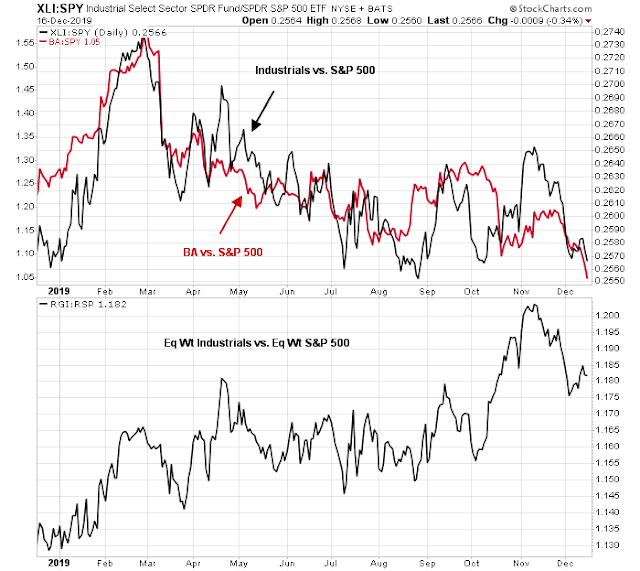As regular readers know, I have been an advocate of taking an overweight in cyclical exposure in equity portfolios (for the latest update, see Adventures in banking). While I continue to believe that the approach is sound, the reality has been less than fully satisfactory in the US. Among the cyclical groups, the semiconductors are on fire, and homebuilding stocks are weakening but remain in a relative uptrend. However, both industrial and transportation stocks have failed to hold their upside breakouts through relative downtrends, though they are still exhibiting bottoming patterns.
Here is what I believe is wrong, and it is a lesson between theory and practice in factor investing.
Pure vs. naive factor exposure
The disappointing returns can mainly be explained by the performance of specific large cap stocks that have dragged down certain sectors. The largest weight in the industrial stock ETF (XLI) is Boeing (BA), whose returns were plagued by the problems of the 737 MAX. The returns of the equal weighted industrial ETF against the equal-weighted SPX benchmark looks a lot more constructive.
In the course of conducting this analysis, I found another cyclical sector whose performance was weighted down by a heavyweight, namely the consumer discretionary stocks. In this case, it was Amazon (AMZN). The same comparison of the relative performance of the cap weighted consumer discretionary ETF (XLY) against the equal-weight ETF shows a similar effect. Equal-weighted consumer discretionary stocks (RCD), which minimizes the effects of AMZN, have bottomed against the market, and they are turning up.
There are several lessons to be learned. Even if your analysis comes to the right conclusion, how you implement the idea or factor makes a huge difference to returns. This exercise is also a lesson on the differences between the pure and naive exposure to a factor.
For investors who want US cyclical exposure, consider RGI, RCD, SMH, and ITB or XHB.



Hi Cam:
Thank you for the great analysis. It’s really helpful that you added recommendations for countries & sectors in many recent posts.
I suppose you are bullish on XLF as well?
Thanks.
Kevin
Yes bullish XLF. A subscriber also asked me about European financials. Use EUFN as a way to get exposure.
Thanks. Really appreciate. I have been 120% invested with margins since late October and heavily into Semis. Your analysis on these sectors would be a great help for my timing.
Anything for the TSX? Thanks.
Behind the global/cyclical recovery based on Cam’s writing is oil/energy which has been in a funk for five years, since Thanksgiving 2014. Some of these oil super majors are money printing machine. These companies dig out money. Some of these companies are throwing out massive dividends (XOM, CVX, BP, RDS-B, TOT). I am unsure if these are historic numbers or not.
Midstream companies are throwing out even larger dividends (Enterprise products, Plains All America). If energy is down and out, for as long as it has been for building a lifetime portfolio, when does one buy these names, if not now?
Energy stocks may appear to be value, but they are not exhibiting any relative strength, which may indicate a value trap (for now). It depends on how long you are willing to be patient.
Ditto for the TSX in answer to the question from another reader. Not exhibiting any signs of relative strength leadership. Or Australia for that matter.
I should rephrase, sorry.
How can Canadians get exposure to European Financials using ETFs trading on the TSX? Thanks.
I am unaware of any European financials ETFs listed in Canada. There is a liquid US-listed ETF, ticker: EUFN
I always check this page for ETFs listed in Canada: https://en.wikipedia.org/wiki/List_of_Canadian_exchange-traded_funds
There is one etf called: First Asset European Bank ETF – Ticker is FHB
But I suppose it’s liquidity won’t be good, which is the case for most of foreign equity etfs listed in CA
Yes. FHB has average daily volume of about 3,000 shares. Not something you really want to trade unless you are forced to stay in Canadian listed securities.
Thanks!